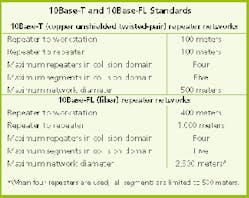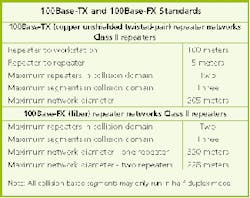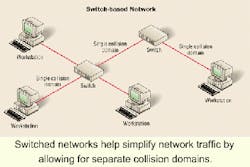As networks grow in speed and area, they can also grow in complexity. Here's how to minimize expansion headaches.
Cheri Podzimek / Transition Networks Inc.
Dan Harmon / 3M/Volition
Local area networks are growing at increasingly rapid rates-growing larger in terms of diameter, number of users, cable speed, and features. Every network architect today wants to know how to make their network bigger and faster. The trick, however, is to keep networks from also increasing in complexity.
The keys to simplicity lie in reducing or eliminating shared network segments, consolidating and eliminating equipment rooms, using long-distance fiber runs, and wisely deploying switching features like VLAN, Layer 3, port trunking, and physical layout to reduce the bandwidth requirements of the backbone. To accomplish that, it's important to understand the new technologies enabling this expansion and how best to use them.
Here's a brief look at the basic rules that have governed networking-and the way they are evolving to meet emerging network needs.
Evolution of the 5-4-3 rule
In the past, many networks used shared Ethernet designs. These networks were limited by the latency of coaxial cables and the use of cable repeaters. To address this, IEEE 802.3 specified that a network could include no more than five segments, four repeaters, and three populated segments, resulting in the "5-4-3 rule."
The use of repeaters has become more complicated as network speeds have increased. Using 10Base-T networks, you could have four repeaters per segment. This number was reduced to two for 100Base-TX networks, which makes it difficult to build large networks without incorporating bridges (switches) or routers. To address this issue, manufacturers develop ed "stacking hubs" that allowed four or five interconnected hubs to perform as if they were a single hub, thereby offering the port density needed to build a larger network.
Today, however, switched networks represent a more popular approach. The use of switches helps simplify network traffic by allowing for separate collision domains.
Where switches are involved, IEEE rules are clear. Every point-to-point switched link is an independent network segment and collision domain, one in which no collisions may occur. The only rule that a network architect has to worry about is the distance limitation of the cable, given the cable speed and "duplexity."
Another "rule" that has evolved as networks have changed is the 80/20 rule, typically used to deploy adequate bandwidth as networks expanded. Essentially, this rule says that 80% of network traffic remained within a workgroup and 20% moved between workgroups along the backbone. This condition was true as long as each workgroup maintained its own services.
In today's environment, this rule has been turned on its ear. Today, 80% of network traffic may move along the backbone and only 20% may re main withinthe workgroup. This condition exists because of the advent of concentrated server farms and Inter net connectivity. In fact, in a school environment, it is possible that 100% of workgroup traffic will move over the backbone and to the Internet.
In real-world terms, that means it's possible to deploy a 3.6-Gbit/sec switch in a workgroup environment and link it to the core (backbone) switch with a single 1-Gbit/sec uplink and still fulfill the requirements of an 80/20 network. A network operating under the 20/80 rule would require 80% of 3.6 Gbits/sec, or a 2.9-Gbit/sec link to the core switch.
Fiber optics provides the best of both worlds. The long distances supported by fiber-optic cable allow the concentration of servers and switches in a central area; they can still can be organized into "virtual" workgroups. That reduces the need for extremely high backbone bandwidths like those required when using server farms and copper networks.
Expanding the diameter
As networks increase in size, three of the most critical "enabling" technologies are switches, fiber optics, and media conversion. These are crucial in that they can help reduce the complexity of the network by streamlining network traffic and distributing network equipment throughout the physical plant.
Switches are Layer 2 devices that help eliminate collisions by allowing separate collision domains. These devices examine the address of the packet and redirect it to the area of the network it is intended to reach, allowing network administrators to predict and deploy bandwidth based on traffic measurements.
Fiber-optic cable affects the distribution of network equipment throughout the physical plant by allowing distances of up to 300 meters between closets and providing fewer points of administration. Optical fiber also provides the bandwidth needed to upgrade networks to higher-speed protocols downstream.
Using fiber is an excellent way to futureproof a network, but the migration to fiber is not an all-or-nothing proposition. Media conversion allows network administrators to capitalize on optical fiber's distance characteristics, because it allows the conversion of copper to fiber at any point in the network. This flexibility provides a cost-effective migration strategy as it allows network managers to leverage their installed base of electronics.
To maximize the network size and performance outlined above, it is important to use the right media converter for the application. When connecting a full-duplex device, a standard Fast Ethernet media converter is appropriate. But in a half-duplex environment, such as between two hubs, a bridging media converter converts the cable media from copper to fiber and breaks the collision domain so that full performance and distance are achieved.
Keeping it simple
The evolution of networks is continuous, driven by the ever- increasing need to carry more information faster to more users. But the solution does not need to become complex. The use of devices such as switches and media converters, coupled with the bandwidth and distance capabilities of fiber, gives network architects the tools they need to build networks that provide the performance they need, without compromising network maintenance, upgradability, or reliability.
Cheri Podzimek is vice president of marketing at Transition Networks Inc. (Minneapolis, MN). She can be reached at [email protected]. Dan Harmon is an application engineer at 3M/Volition. The authors wrote this article on behalf of the TIA Fiber Optic LAN Section. Member companies include 3M/Volition, Allied Telesyn International, AMP Netconnect, Belden Wire & Cable, Berk-Tek, CommScope, Corning, LANCAST, Lucent Technologies, Micro Linear, Ortronics, Panduit, the Siemon Co., Siecor, Sumitomo Electric Lightwave, and Transition Networks.
This article orginally appeared in the May 2000 issue of Lightwave magazine, a sister publication.




